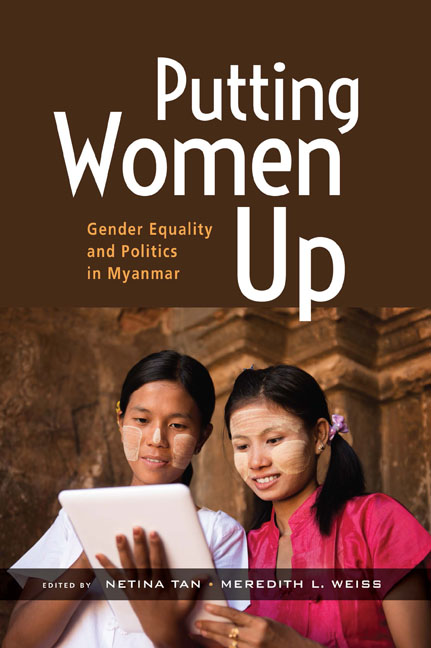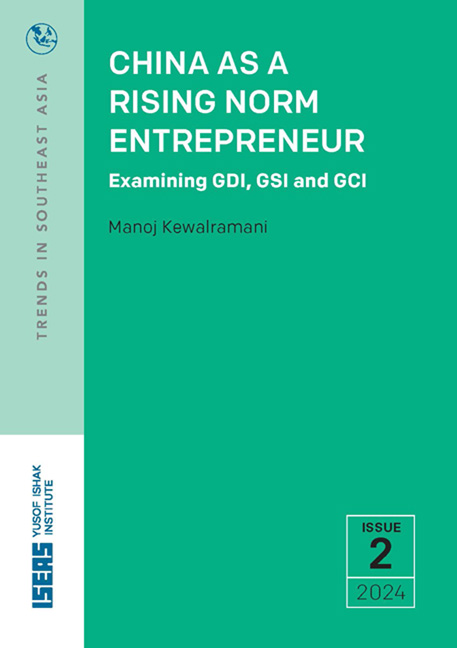Refine listing
Actions for selected content:
15726 results in ISEAS-Yusof Ishak Institute
Why Young Malay Voters in Malaysia Are “Turning Green”
-
-
- Book:
- Why Young Malay Voters in Malaysia Are 'Turning Green'
- Published by:
- ISEAS–Yusof Ishak Institute
- Published online:
- 04 July 2025
- Print publication:
- 02 May 2024, pp 1-24
-
- Chapter
- Export citation
Why Young Malay Voters in Malaysia Are “Turning Green”
-
-
- Book:
- Why Young Malay Voters in Malaysia Are 'Turning Green'
- Published by:
- ISEAS–Yusof Ishak Institute
- Published online:
- 04 July 2025
- Print publication:
- 02 May 2024, pp vii-viii
-
- Chapter
- Export citation
Myanmar’s Resistance and the Future of Border Trade: Challenges and Opportunities
-
-
- Book:
- Myanmar's Resistance and the Future of Border Trade
- Published by:
- ISEAS–Yusof Ishak Institute
- Published online:
- 04 July 2025
- Print publication:
- 25 April 2024, pp 1-21
-
- Chapter
- Export citation
Frontmatter
-
- Book:
- Myanmar's Resistance and the Future of Border Trade
- Published by:
- ISEAS–Yusof Ishak Institute
- Published online:
- 04 July 2025
- Print publication:
- 25 April 2024, pp i-iv
-
- Chapter
- Export citation
Myanmar’s Resistance and the Future of Border Trade: Challenges and Opportunities
-
-
- Book:
- Myanmar's Resistance and the Future of Border Trade
- Published by:
- ISEAS–Yusof Ishak Institute
- Published online:
- 04 July 2025
- Print publication:
- 25 April 2024, pp vii-viii
-
- Chapter
- Export citation
Foreword
-
-
- Book:
- Myanmar's Resistance and the Future of Border Trade
- Published by:
- ISEAS–Yusof Ishak Institute
- Published online:
- 04 July 2025
- Print publication:
- 25 April 2024, pp v-vi
-
- Chapter
- Export citation

Putting Women Up
- Gender Equality and Politics in Myanmar
-
- Published by:
- ISEAS–Yusof Ishak Institute
- Published online:
- 18 April 2024
- Print publication:
- 06 February 2024

Timor-Leste in ASEAN
- Is It Ready to Join?
-
- Published by:
- ISEAS–Yusof Ishak Institute
- Published online:
- 18 April 2024
- Print publication:
- 11 January 2024

Enhancing ASEAN's Role in Critical Mineral Supply Chains
-
- Published by:
- ISEAS–Yusof Ishak Institute
- Published online:
- 17 April 2024
- Print publication:
- 08 February 2024

Visiting Sexual Exploitation
- How Should Indonesia Strengthen Its Policies to Curb Sex Work in Response to Its Extramarital Sex Criminalization
-
- Published by:
- ISEAS–Yusof Ishak Institute
- Published online:
- 16 April 2024
- Print publication:
- 01 February 2024

China as a Rising Norm Entrepreneur
- Examining GDI, GSI and GCI
-
- Published by:
- ISEAS–Yusof Ishak Institute
- Published online:
- 16 April 2024
- Print publication:
- 15 January 2024

China's Cultural Diplomacy in Indonesia
- The Case of a Transnational Singing Contest
-
- Published by:
- ISEAS–Yusof Ishak Institute
- Published online:
- 16 April 2024
- Print publication:
- 08 February 2024

How Thailand's Move Forward Party's Fandom Strategy Shaped the 2023 General Election
-
- Published by:
- ISEAS–Yusof Ishak Institute
- Published online:
- 16 April 2024
- Print publication:
- 10 March 2024
Index
-
- Book:
- Games, Changes, and Fears
- Published by:
- ISEAS–Yusof Ishak Institute
- Published online:
- 03 July 2025
- Print publication:
- 16 April 2024, pp 348-361
-
- Chapter
- Export citation
List of Figures
-
- Book:
- Games, Changes, and Fears
- Published by:
- ISEAS–Yusof Ishak Institute
- Published online:
- 03 July 2025
- Print publication:
- 16 April 2024, pp ix-ix
-
- Chapter
- Export citation
8 - A Quixotic Quest? Electoral and Political Reforms from Duterte to Marcos Jr.
-
-
- Book:
- Games, Changes, and Fears
- Published by:
- ISEAS–Yusof Ishak Institute
- Published online:
- 03 July 2025
- Print publication:
- 16 April 2024, pp 203-228
-
- Chapter
- Export citation
7 - Tsek.ph and the Media’s Pushback against Digital Disinformation
-
-
- Book:
- Games, Changes, and Fears
- Published by:
- ISEAS–Yusof Ishak Institute
- Published online:
- 03 July 2025
- Print publication:
- 16 April 2024, pp 171-202
-
- Chapter
- Export citation
Contents
-
- Book:
- Games, Changes, and Fears
- Published by:
- ISEAS–Yusof Ishak Institute
- Published online:
- 03 July 2025
- Print publication:
- 16 April 2024, pp v-vi
-
- Chapter
- Export citation
3 - From Entrepreneur to Saboteur: How the Philippines Won and Lost the South China Sea on Social Media
-
-
- Book:
- Games, Changes, and Fears
- Published by:
- ISEAS–Yusof Ishak Institute
- Published online:
- 03 July 2025
- Print publication:
- 16 April 2024, pp 59-83
-
- Chapter
- Export citation
13 - (Dis)continuities and Disruptions in Labour Migration Governance: The Philippines from the Duterte to the Marcos Jr. Administration
-
-
- Book:
- Games, Changes, and Fears
- Published by:
- ISEAS–Yusof Ishak Institute
- Published online:
- 03 July 2025
- Print publication:
- 16 April 2024, pp 327-347
-
- Chapter
- Export citation
